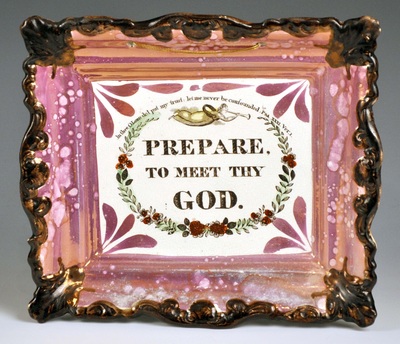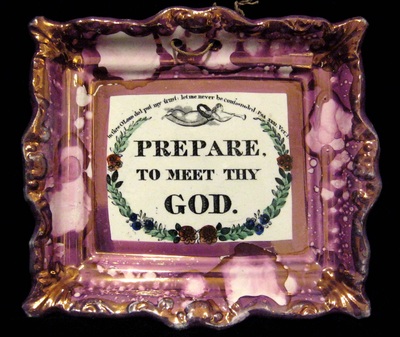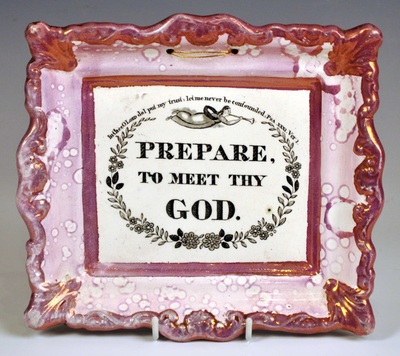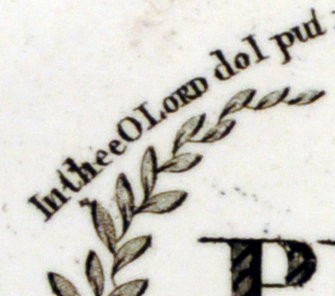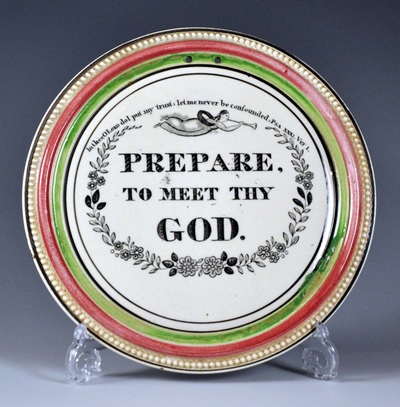|
If you look closely at the Sunderland 'Prepare to meet thy god' plaques, it's apparent that there are multiple variations of the same transfer. Sometimes the differences are obvious – an angel facing in one direction or another – and sometimes they're minute – a leaf shaded on a different side, a flower bud with or without a stalk. The smaller differences are interesting in as much as they hint at the way that plaques were produced. Anthony Scott of Southwick had several near-identical copper plates made up for his more commercial transfers (see the Scott page for photographs of two plates used to generate John Wesley transfers). Transfer plates wore out, and sometimes needed repair or replacement. But Scott apparently used his plates side by side to increase production, or perhaps to allow production of items with the same transfer at different locations within his factory. N.B. designs were first printed onto tissue paper, which had to be applied to pottery while the ink was still wet, so the copper transfer plates would have been kept close to the area of production. The small differences of engraving, and the occasional scratches or dinks in the copper, allow us to trace with certainty the movement of the transfer plate from one pottery to another, e.g. when a pottery closed. Up until now, I had identified 4 near-identical variations of the same 'Prepare to meet thy god' transfer used by Scott, and the neighbouring Moore & Co factory (they often shared transfers). But I hinted that there may be a fifth, confirmation of which has come through this plaque, currently listed on eBay. Compare it in the line up below (shown second) with the three other plaques. The first two are attributed to Scott, and the second two to Moore & Co. We know that they are all from the same transfer plate because there were small dinks in the copper transfer plate that appear as black dots to the left of the letter 'G' in the second detail. I've ordered the plaques, newest first (the top plaque perhaps as late as the 1870s, and the bottom as early as the 1850s) – the marks appear to have become more numerous, and to show up as darker over time. Below is another group of plaques that until now I'd thought came from the same transfer plate as those above. The leaves are all shaded on the same sides, the buds are connected to the flowers with stalks in the same way (see second detail). The first soup bowl has a 'SCOTT' impressed mark, the next three plaques, although unmarked, are typical of Moore & Co. But none of them has any trace of the marks to the left of the letter 'G'. Also, unlike the plaques above, there is no space between the word 'thee' and 'O' in the first detail, and the word 'thee' seems set slightly lower down. At first I thought perhaps the lettering had shifted when the transfer plate had been hammered flat (N.B. the plates, repeatedly passed through rollers, sometimes curled over time). In that case the items below could have been made before the plaques above: i.e. before the dinks appeared to the left of the 'G'. But the soup bowl is too late for that, I think. So there had to be some other difference between the two groups. If you look at the bottom right leaf in the first detail of all the plaques above, there's a striking difference between the first group (see below left) and the leaves in the second group (see below right). In the second group the leaf is longer, and in most of that group, there's evidence of a scratch running off the leaf to the right. This shows beyond doubt that the two groups come from different transfer plates. Interestingly, both plates seem to have started their life at Moore's and ended up at Scott's.
There are a whole series of transfers shared by the two potteries (click here to read about some of them). But in each case, the copper plates must have started work at either one pottery or the other. These small differences help us untangle which pottery was making what, and when. I will update the 'Prepare to meet thy god' page when I get a second. Thanks to Georgina at Swan Antiques for providing the photo of their plaque on eBay.
0 Comments
|
AuthorStephen Smith lives in London, and is always happy to hear from other collectors. If you have an interesting collection of plaques, and are based in the UK, he will photograph them for you. Free advice given regarding selling and dispersal of a collection, or to those wishing to start one. Just get in touch... Archives
February 2022
AcknowledgementsThis website is indebted to collectors, dealers and enthusiasts who have shared their knowledge or photos. In particular: Ian Holmes, Stephen Duckworth, Dick Henrywood, Norman Lowe, Keith Lovell, Donald H Ryan, Harold Crowder, Jack and Joyce Cockerill, Myrna Schkolne, Elinor Penna, Ian Sharp, Shauna Gregg at the Sunderland Museum, Keith Bell, Martyn Edgell, and Liz Denton.
|

